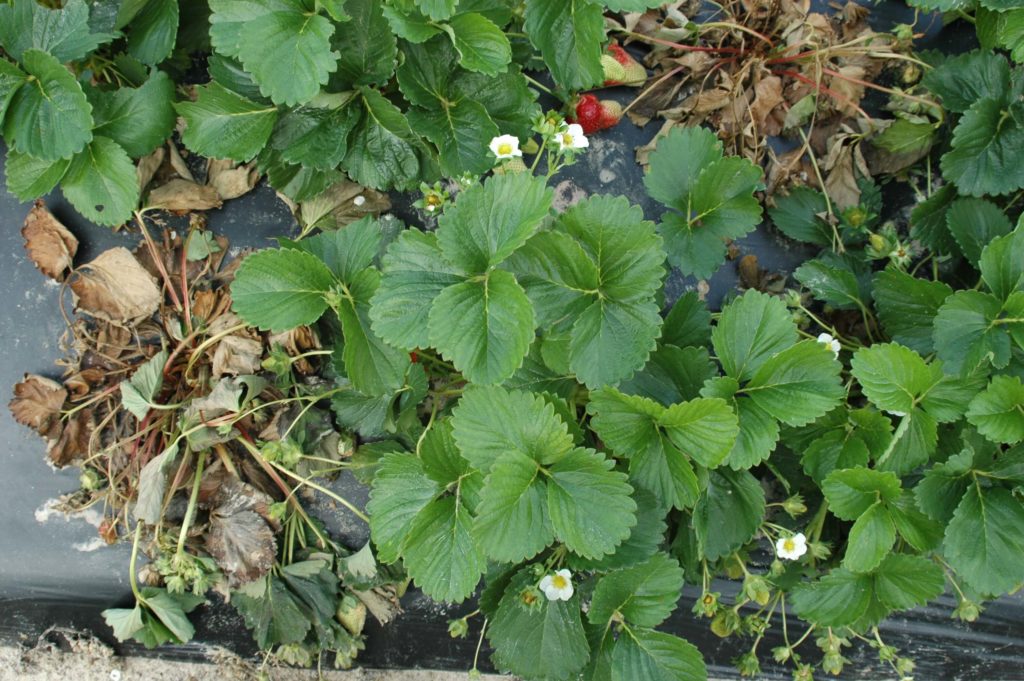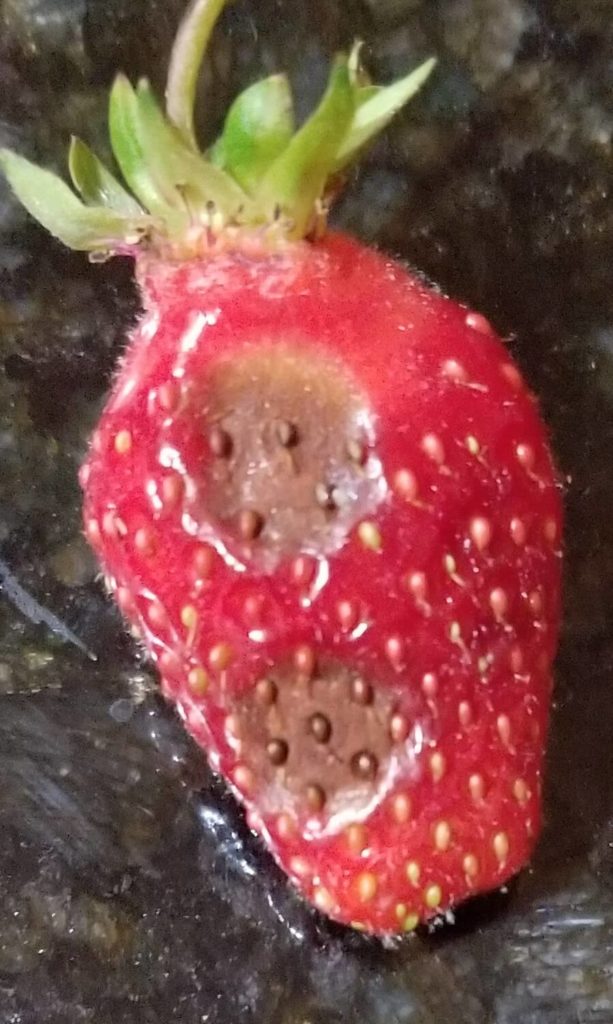Mahfuz Rahman1 and Jayesh Samtani2; 1West Virginia University, Morgantown, WV, Email: mm.rahman@mail.wvu.edu ; 2 Hampton Roads Agricultural Research and Extension Center, Virginia Tech., Virginia Beach, VA.
Anthracnose is one of the most destructive diseases of strawberry affecting fruit growers in the southeastern United States. Although all parts (crowns, runners, petioles, blossoms, fruits) of the strawberry plant can be affected by the disease, the most obvious symptoms are expressed from crown and fruit infections. Crown rot due to crown infection manifests as wilting of the whole plant (Fig. 1) and can result in a total loss depending on the plant stage when infection takes place. Fruit can be infected at the green or ripening stage but the most conspicuous symptoms such as black sunken lesions (Fig. 2) appear on ripening or fully ripened berries. Anthracnose crown rot (ACR) is a high temperature-loving disease and is mostly a problem in the southeastern United States where warm, moist conditions and abundant rainfall favor the growth and rapid dissemination of the pathogen. However, anthracnose fruit rot (AFR) can be a problem anywhere strawberries are grown.
Causal Agent, Spread of the Disease, and Diagnostics
Fungal pathogens belonging to the Colletotrichum gloeosporioides and C. acutatum species complexes cause ACR and AFR, respectively, with some minor exceptions. Although inoculum sources for plants in fruiting fields can be diverse, non-symptomatic infected (quiescent or latent) planting stock is one of the most important sources of inoculum. Thus, the use of “disease-free transplants” is the first and most effective method for controlling anthracnose in the fruit production field. Due to the vegetative propagation of strawberries, infection at any stage in the propagation nursery, plug production facility, or fruiting field can pose a risk, although symptom expression on foliage is rare unless the infection level is very high. This infection biology poses a challenge to growers due to a lack of knowledge about the plant’s health and whether they would need to take any preventative measures to manage the disease in their fields.
Diagnostic evaluation of propagation materials for latent infection from representative samples can aid in decision-making for disease prevention and management. While fruit growers expect to secure disease-free plants, it is often difficult for suppliers to ensure truly healthy plants for the same reason mentioned above. Research on developing a sensitive and cost-effective latent infection diagnostic method is in progress.
Until a standard protocol for this purpose is in place, information from plant nurseries and visual observation of plants can help growers make appropriate management decisions. Laboratories at state land-grant universities may be able to, for a fee, provide an assessment of plant infection.
Disease Management
From our experience, if the pathogen is latently present in a large proportion of plants at the pre-bloom stage, a fungicide program starting from 10% bloom can save the crop from severe losses due to AFR. A list of effective products can be found in the strawberry IPM guide. The spray interval should be dependent on the presence or absence of fungi on foliage and prevailing weather conditions during fruit development and ripening. Although strobilurins or QoI fungicides (FRAC 11) have been among the most effective against anthracnose, they are also highly vulnerable to fungal populations developing resistance to them. These products should only be used as directed in terms of consecutive sprays allowed and the total amount used in a crop year. It is also very important to communicate with plant suppliers about whether any of these products have been used in the nursery or plug production cycle, to avoid excessive applications of the same chemistry. Also, in a situation of control failure, the best option is to rotate the fungicide mode of action. For example, if Pristine fails to provide optimum control, Merivon should not be the alternative as both products have active ingredients from the same FRAC groups (7+11). In this case, Switch (FRAC 9+12) or a multi-site activity product like Captan or Thiram could be considered as an alternative. These products at the same time should provide good gray mold suppression. In most cases, ACR symptoms showing up during fall or early spring suggest a need for a fungicide program. However, detection of the pathogen on transplants may indicate the need for a fungicide dip and subsequent initiation of a spray program within a month of planting. It is extremely important to determine whether crown rot and plant wilting are due to ACR or Phytophthora crown rot by sending samples to a diagnostic lab, as different products are used to manage these two diseases.


Photo credit: Mahfuz Rahman